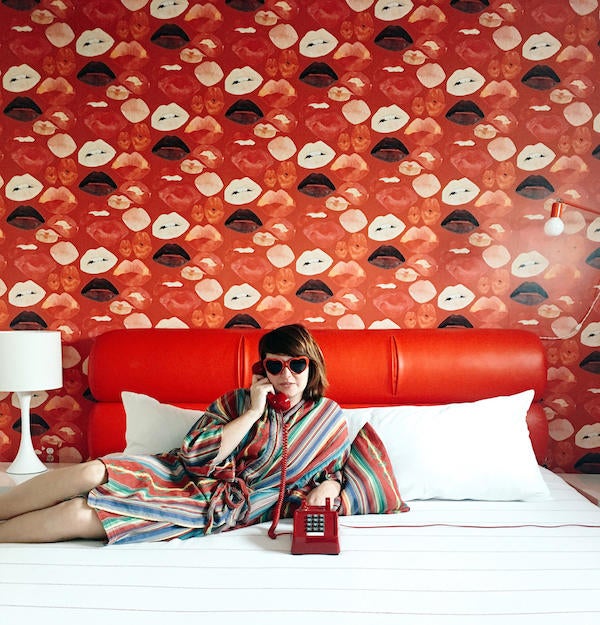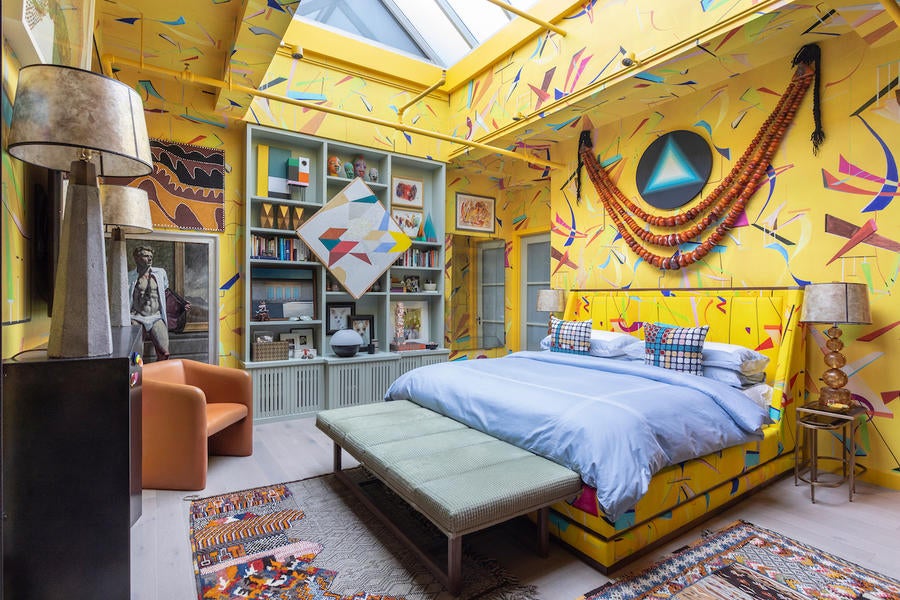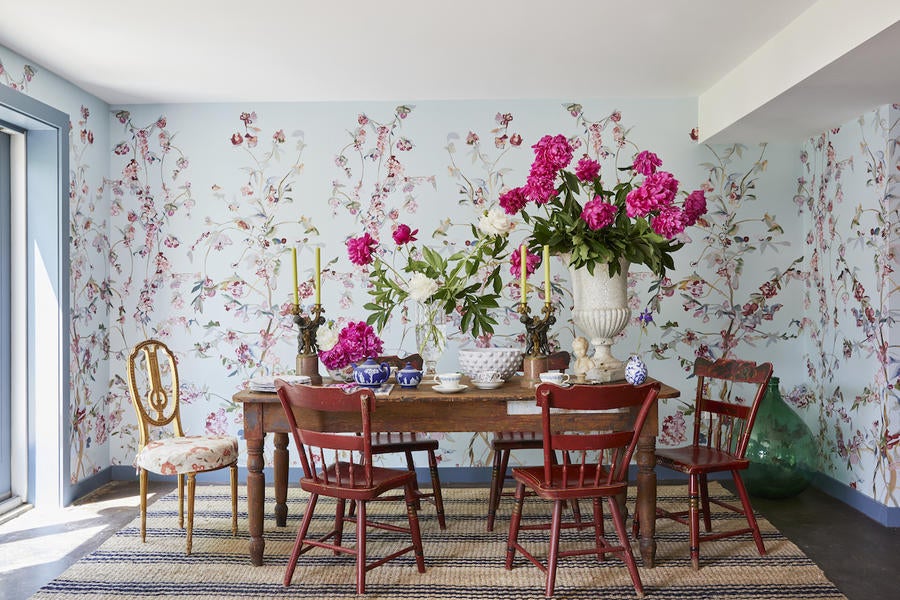It was February, fabric giant Robert Allen Duralee had just filed for bankruptcy, and the textile world felt like it had been turned on its head. I was chatting with a veteran of the industry, trying to get some context on what had happened, and he was ruminating on a backlash against large corporate fabric houses.
"There is a reaction against bigness in the design community,” he told me. “It used to be that finding and repping small niche design lines was almost pointless because of the dominance of the big brands. Now small, cool lines that are specifically not very visible to the consumer are very much in demand. For instance, have you heard of—”
I knew the name he was going to say before he said it: Voutsa.

I first wrote about Voutsa in 2015. At the time, the brand was essentially one person, a young artist named George Venson. Out of a small studio in New York’s Chinatown, Venson was producing wildly inventive wallpaper designs that had captured the attention of industry tastemakers. In a category dominated by conservative patterns and faint toiles, he was painting sumptuous disembodied lips, ballerinas on metallic paper, snakes, octopi, and trees adorned with genitalia.
At the time, he struck me as both enigmatic and sharply intelligent—our conversation looped in disorienting circles before landing on concise, motto-like statements (“Ugly can be chic and chic can be ugly,” for example). Venson was also ambitious. He told me he was inspired by huge brands like Chanel, and wanted Voutsa to grow in that direction—a bold ambition for a designer working out of a tiny studio.
Four years later, Venson is still the driving force behind Voutsa. Everything else has changed. The brand now has its own stand-alone showroom at the New York Design Center, with another coming this fall in Los Angeles, as well as representation in top-tier multi-lines in San Francisco; Austin, Texas; Palm Beach, Florida; and Toronto. Voutsa now sells its patterns on fabric, not just paper, and has launched a designer-friendly customization program. Venson’s designs have dazzled at Kips Bay, and in high-profile hospitality projects like The Peninsula and Four Seasons.
In short: Though Voutsa is still a relatively small brand, Venson is a lot closer to Chanel than he was five years ago. How has he pulled it off?
+ + +
I recently met up with Venson at the cafe in the NYDC to discuss Voutsa’s growth from an atelier into a brand with international reach. As in 2015, our conversation was circuitous and full of interesting digressions. However, he seemed eager to move the conversation away from himself—the only thing that mattered, he kept circling back to, was Voutsa, the brand.
Still, a little backstory. Venson grew up in San Antonio, and attended Rice University in Houston. He studied art there and took advantage of the school’s multidisciplinary focus, acting in films, painting, making work of various types. “I think medium specificity is kind of a dated thing. It’s weird that you apply to Yale and you have to apply to the sculpture department or the painting department,” says Venson. “The entire canon of contemporary art has been about blurring all these lines.”
After graduating in 2008, he moved to New York and began working for artists and galleries. He was also producing work of his own, some of it video and performance art, some of it drawing and painting. Around 2011, he began experimenting with prints, which, after two years of growing disillusionment with the art world, led to wallpaper.
“I just watched the art world getting commercialized and I said, ‘You know what? I am not happy,’” Venson recalls. “It was a more fun, interesting, smarter idea to leave the art world and make products. Most people think you move into the art world because it’s alluring, and it was not alluring. It was like I was watching things get boring.”

Through a friend with connections in design, Venson began producing product and showed some of his work at the Architectural Digest Design Show. The collection was an immediate hit. He describes his transition from fine artist to product designer as quick and absolute: “I just killed that vibe,” he says of his life as an artist. “I had a clean break.”
Ironically, Venson’s artistry is precisely what earned Voutsa its early fan base. Designer Sasha Bikoff discovered Voutsa through an Etsy search and was immediately taken by what is now one of the brand’s best-known patterns: a sea of floating lips. “He has such a free brushstroke, and it’s so emotional, compared to all of these other stagnant patterns that have no life to them,” says Bikoff. “Even though it’s wallpaper, it felt so alive, like the lips were talking—there was so much expression.”
And though Venson had left behind the downtown art scene, he brought with him a kind of downtown ethos. He could be provocative (two early Voutsa patterns: Penis Vine and Vagina Tree) and while his work always had a kind of formal beauty, it wasn’t necessarily “pretty” in the traditional sense—more Jenny Saville than Dorothy Draper. Venson also lived more like an artist than a product designer. He decorated a 275-square-foot “prison-like” apartment in Chinatown entirely with his own patterns, attracting the attention of Wendy Goodman, who profiled the space in New York magazine.
Such qualities made Voutsa stand out in a design world accustomed to staid wallpaper design by traditional manufacturing companies. Not everyone liked the work—but if they liked it, they tended to love it. “It took me several years to understand how to use it,” says designer Drew McGukin. “But it’s really refined. He has a really beautiful understanding of art and design and where they meet. What I find in reaction from clients is at first they say, ‘Oh, wow,’ slightly hesitantly. But then they say, ‘Oh, wow, that’s perfect.’”
As Venson’s profile rose, Voutsa began to grow a devoted fan base of designers and editors. Fortuitously, the company’s early years also happened to coincide with the rise of Instagram—the designer’s eye-catching colors and sui generis patterns were a perfect fit for a platform where difference is currency. A licensed line through Anthropologie came in 2015, and Venson’s work continued to pick up steam.
In 2018, a collaboration with Bikoff for the Kips Bay Decorator Show House was a kind of informal culmination of five years of growth. The brand’s Memphis-inspired Borderline wallpaper adorned the staircase of the Upper East Side mansion—by far the most buzzy room in the space. Voutsa had arrived.
“Did we wake up the next day with a million dollars in our bank account? No,” says Venson. “But everyone was talking about us.”
+ + +
Though Venson has left the art world behind, he has remained intimately involved in the evolution of Voutsa’s artistic voice. Working with assistants, he paints the large-scale original works that are then photographed and manipulated by computer to form repeating designs. Though the brand’s patterns are still evocative and maximalist, over time, Voutsa’s work has gotten slightly softer and more “pretty”—many of the most recent patterns are florals, and the snakes have (mostly) disappeared. “[Now] about 5 percent of our offering could be used in a formal dining room,” says Venson—certainly an uptick from where he started.

Venson has also refined Voutsa as a business. Though he occasionally couched decisions in somewhat vibey language, his choices tended to reflect an underlying strategic nous. For example, at many points during our conversation, Venson affectionately referred to each of his patterns as having a voice, or being a member of the Voutsa family. But when describing how he chooses which are displayed in the showroom, his tone changed. “I don’t have any personal emotional attachment to patterns. We literally get an Excel spreadsheet that tells us how much each one makes, and the [patterns at the] bottom [of the list] get cut. If it’s on a board downstairs [in the showroom], it sells.”
Whether guided by intuition or analytics, many of Venson’s moves have proven to be savvy. Early on, he chose to copyright his patterns and retain ownership rather than sell them to a larger company who could handle production. Now that his profile has grown, he comes to any potential licensing partnerships in a much stronger position. Venson told me growth has been steady, and that Voutsa has seen increases in revenue quarter after quarter.
“What’s always impressed me is that [Venson] does have this faux-flighty artistic side to his personality,” says McGukin. “But he has this incredible brain for business. He knows what he wants and he’s very directed.”
What Venson wants now is to focus on designers. As Voutsa grew, perhaps following his multidisciplinary roots, he began branching out into other categories. There were Voutsa sneakers, caftans, wrap dresses and robes—and Venson designed the costumes for a contemporary dance show.
In late 2017, he moved out of Chinatown and combined his studio with a new second-floor showroom in SoHo. The location gave him a public place to showcase his growing brand, but it was plagued by issues. The buzzer continually broke and the location was a tough sell for some designers. More conceptually, for Venson it was an awkward mix to combine the artistic and commercial sides of the business.
“What became super clear was that I don’t mind having a living space and studio combined, but the showroom really needs to be separate,” he says. “The painting stage is informal. My assistants aren’t dressed to talk to designers, who are coming to shop with fancy clients from the Hamptons. It was the wrong fusion.”
In August 2018, Venson moved Voutsa’s showroom to the New York Design Center, and his own studio to a vegan farm in upstate New York. The reshuffling coincided with a decision to leave clothing behind—however, he had quietly added fabric to his catalog. “There was a point where I said, ‘OK, we’re doing all these little things that are taking away from the potency of a really solid textile line,’” he says. “So we sold everything and I started focusing.”
The result is a reimagined Voutsa, one much more clearly oriented around designers’ needs. The company’s entire collection of patterns is now offered on five types of paper (including Type II for commercial projects) and printed here in the U.S.—as well as five fabrics, which are produced in Italy.
In addition, Voutsa has rolled out a customization program. Designers can now work with the studio to make certain changes to scale, colorway and artwork for formalized, preset pricing. The program, Venson says, is an effort to streamline requests coming in from designers that before had taken up the studio’s energy and time.
“The refining of this process has been all about trying to capture as many questions with the smallest size net,” he says. Voutsa will still do custom patterns, or site-specific installations for a negotiable price. But now, if designers want simple changes—to alter the background color of the lips pattern, or remove a snake from a design, there’s a set price and a simple process.
For years, the design community has been coming to Voutsa while Venson experimented. Now, he’s paring down and coming to them.
+ + +
It’s hard to know whether the rise of a brand like Voutsa says something broadly about the design industry, or whether it’s simply about Voutsa. Certainly, the public struggles of textile giants like the Robert Allen Duralee Group may be indicative of a tectonic shift away from massive conglomerates and toward individual makers. There are many who think so.
“It’s almost like it’s circling back,” says McGukin. “It used to be that interior design was quite special, the whole thing was about specialized artisans and makers doing special things. But it became so huge, with companies like Kravet and Robert Allen acquiring everything. It’s gotten so big-box that people want something that feels more intimate now.”

However, just as brands like Voutsa may be poised to capture a growing market for unique design, they’re uniquely vulnerable. Without huge reserves of capital or a diversified risk pool, small, specialized companies can fall prey to shifting economic winds. Voutsa’s rise has coincided with a period of economic expansion—Venson’s business has yet to face a recession.
A company with a strong artistic voice is also vulnerable to the vagaries of taste. Venson told me it was a concern he carried in the back of his head, alongside day-to-day worries like payroll, rent and logistics—that minimalism could roar back as the dominant aesthetic, and “More is more” practitioners could be pushed to the side. “I don’t think anybody should make their own fabric line,” he says, laughing. “It is so, so difficult. It’s so crazy and there are so many loopholes and problems.”
When I asked Venson what he sees for the future of the brand, he outlined three possible scenarios. One would be to sell the company, exit completely and restart his life. The next would be to grow Voutsa to a “healthy, stout, midsize” business with a team of 12. (Currently, the brand has four full-time employees and a team of freelancers.) Finally, if Venson were to line up an infusion of capital, he could see taking the brand much, much bigger: “I don’t have any prejudice against high or low,” he said. “I’d love to do a Target line, I’d love to reach a mass audience.”
Though he had pitched three radically different visions for the future, Venson seemed to find each one of them compelling in its own way. ”Depending on the time of day, or the day of the week, they’re all equally appealing,” he says. Whatever the direction, Venson is trying to fade into the background and let the brand speak for itself. “I have no desire to walk into a room and have anybody know who I am or what I’m doing,” he says. “I’m very into killing this whole [idea] that I’m some sort of magician who does everything.”
Homepage photo: Daniel Trese




























